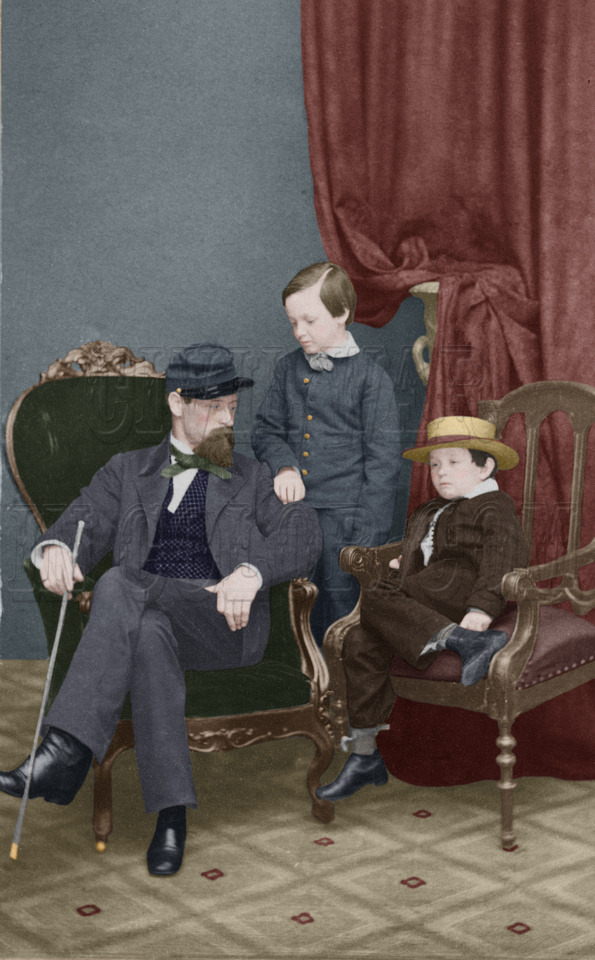#willielincoln
Text
Victorian Hair Keepsakes
During the Victorian era, keeping locks of hair as mementos of absent or deceased loved ones was popular among Americans of all classes. Locks of hair were encapsulated in lockets and brooches; woven into rings, necklaces, and bracelets; used to create wreathes and other decorative pieces for display; and cased in hinged frames that could be set on a desk or dressing table or carried in a pocket or purse. The Lincoln Financial Foundation Collection has locks of hair from members of the Lincoln family, an antislavey politician, and a Union soldier.
After Abraham Lincoln’s assassination, Mary Lincoln requested that the doctors cut a lock of the president’s hair for her. The doctors participating in the postmortem each received a lock as well, as did the undertaker. Recipients of the locks often passed portions—sometimes just a few strands—on to others.

This single curl of dark brown hair was folded into a note that reads “President Lincoln, hair.” The note was then put into an envelope labeled “President Lincoln's hair and Robert Lincoln's note.”


This lock of Lincoln's hair is tied in a circle with fine thread and encased in a 3-by-5-inch black octagonal daguerreotype case. The outside of the case has a raised floral and scroll-work design with a gold oval in the center embossed with a leaf design. The case opens on two hinges to reveal a purple crushed velvet lining on one side and the lock of hair framed in a hammered gilt oval on the other.

Just a few strands of Lincoln’s hair are encapsulated in this memorial brooch. The brooch is about 1¼ inches in diameter and has a decorative edge and pin backing.

Although Lincoln’s hair was distributed outside his immediate family, most commemorative locks of hair were closely held family keepsakes. This lock of Mary Lincoln’s hair was likely intended for family. It is tied with a tiny ribbon bow and encased in a daguerreotype case opposite a photograph of Mary as First Lady. It is not known when the lock of hair was cut, but it was framed sometime after January 1862, when this photograph was taken.

Willie Lincoln’s death at age 11 on February 20, 1862, devastated both his parents. This lock of Willie’s hair may have been cut at that time and placed in this small case opposite a red silk velvet lining. The lock is tied into a circle and pressed behind glass surrounded by a gilt frame.


Julia Hastings, the niece of Massachusetts Senator Charles Sumner, kept this lock of her uncle’s hair folded carefully into an envelope of paper. Sumner was elected to the U.S. Senate in 1851, where he was an outspoken champion of the antislavery cause. In 1856 he was assaulted at his Senate desk by proslavery congressman Preston Brooks of South Carolina and severely beaten. He returned to his Senate seat in 1859 and was the leader of the Radical Republicans during the Civil War. But this lock of the famous man’s hair was kept in the family.


Thirty-two-year-old Otis Moody enlisted in the 51st Illinois Volunteers a few months after the outbreak of the Civil War in 1861. From that time until his death at Chickamauga in September 1863, Moody wrote letters to his sweetheart, Annie Noble. In his letter written from “Camp near New Madrid” [Missouri] on April 6, 1862, he enclosed this lock of his hair, noting that “I will send you…Also some more of my hair as I believe you wanted some.”

Keeping loved ones’ locks of hair has largely gone out of fashion in the 21st century, but for Victorians these mementos of absent family members and sweethearts were precious keepsakes.
9 notes
·
View notes
Photo

Pres. Abraham Lincoln’s sons Willie and Tad Lincoln with their cousin Lockwood Todd - 1861
"It is my pleasure that my children are free, happy and unrestrained by parental tyranny. Love is the chain whereby to bind a child to its parents." Abraham Lincoln
Both Mary and Abraham Lincoln, for different reasons, didn't have happy childhoods. To the displeasure of others, both parents were known to indulge their children.
In October of 1847, as the family journeyed to Washington D.C., they stopped in Lexington to visit the Todd relatives.
By chance, Mrs. Todd's nephew, Joseph Humphreys had been traveling on the same train as the Lincolns. Arriving at the Todd home before them, Humphreys immediately began describing his journey:
"Aunt Betsy, I was never so glad to get off a train in my life. There were two lively youngsters on board who kept the whole train in turmoil, and their long legged father, instead of spanking the brats, looked please as Punch and aided and abetted (them) in their mischief."
As he looked out of the window, he could see the family getting out of a carriage. Horrified, Humphreys exclaimed, "Good Lord! There they are now!" He was not seen again at the Todd's until after the Lincolns left.
Not everyone had the same reaction to the Lincolns as Humphreys. For the next three weeks the Lincolns visited Mary's many relatives. Lincoln romped with Bobby, Eddie and Emilie, Mary's nine-year-old half-sister. The future widow of Confederate General Ben Helm recalled that at the end of their time together, "we hated to see them go".
#abrahamlincoln#preslincoln#willielincoln#tadlincoln#marylincoln#emiliehelm#emilietoddhelm#fathersday#historyinfullcolor#historyincolor#civilwarincolor#civilwarcolorphoto#civilwarphoto#lockwoodtodd
2 notes
·
View notes
Photo

A big CONGRATULATIONS to George Saunders for winning this years Man Booker Prize! Our stock is fast running out - so you best be quick if you want to get a copy! . . . . . #books #bookporn #booksale #shelfie #bookshop #bookstore #bookstagram #bookworm #booklove #booklover #read #reader #bookfacefriday #dymocks #dymocksbooks #dymocks234 #melbourne #dateabook #datereaders #readingproblems #manbookerprize #manbookerprize2017 #lincolninthebardo #georgesaunders @bloomsburypublishing #literature #awardwinner #lincoln #willielincoln #bardo #tibet
#reader#booksale#read#bardo#lincolninthebardo#booklover#tibet#shelfie#dymocksbooks#bookstagram#booklove#dymocks#dateabook#bookshop#bookworm#awardwinner#dymocks234#literature#bookstore#lincoln#georgesaunders#willielincoln#manbookerprize2017#datereaders#books#melbourne#bookfacefriday#manbookerprize#bookporn#readingproblems
0 notes